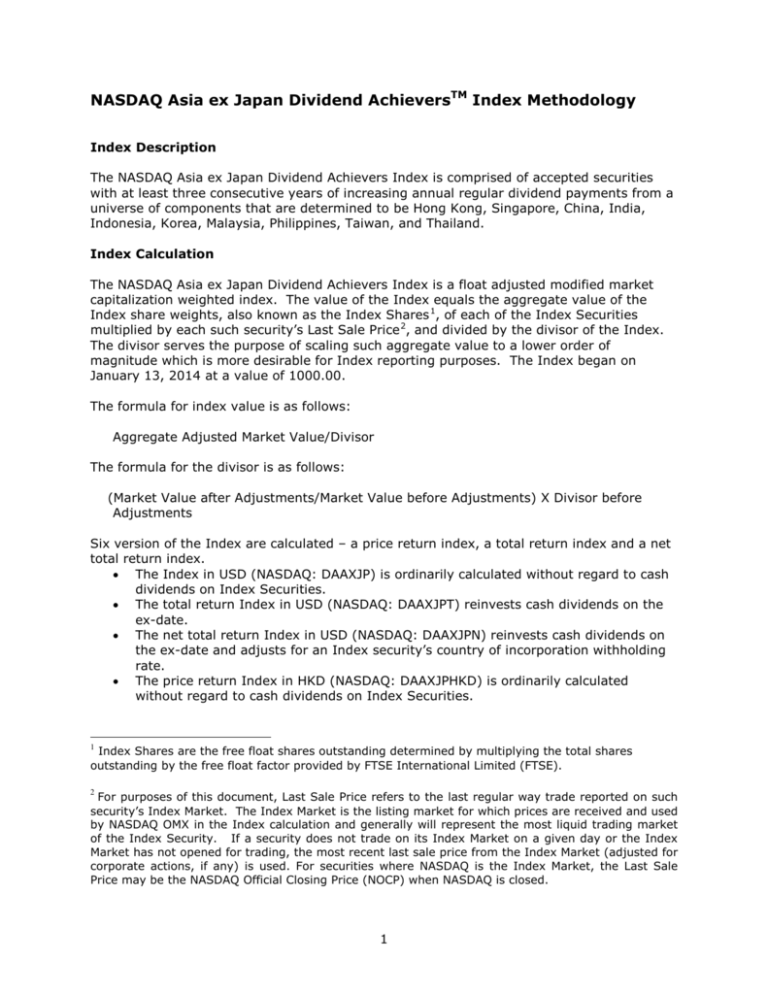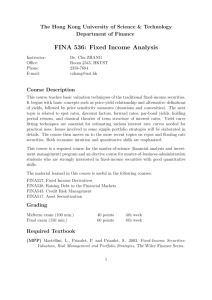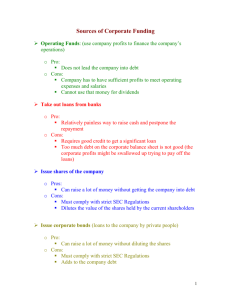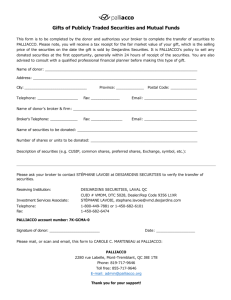NASDAQ Asia ex Japan Dividend AchieversTM Index Methodology
advertisement

NASDAQ Asia ex Japan Dividend AchieversTM Index Methodology Index Description The NASDAQ Asia ex Japan Dividend Achievers Index is comprised of accepted securities with at least three consecutive years of increasing annual regular dividend payments from a universe of components that are determined to be Hong Kong, Singapore, China, India, Indonesia, Korea, Malaysia, Philippines, Taiwan, and Thailand. Index Calculation The NASDAQ Asia ex Japan Dividend Achievers Index is a float adjusted modified market capitalization weighted index. The value of the Index equals the aggregate value of the Index share weights, also known as the Index Shares 1, of each of the Index Securities multiplied by each such security’s Last Sale Price 2, and divided by the divisor of the Index. The divisor serves the purpose of scaling such aggregate value to a lower order of magnitude which is more desirable for Index reporting purposes. The Index began on January 13, 2014 at a value of 1000.00. The formula for index value is as follows: Aggregate Adjusted Market Value/Divisor The formula for the divisor is as follows: (Market Value after Adjustments/Market Value before Adjustments) X Divisor before Adjustments Six version of the Index are calculated – a price return index, a total return index and a net total return index. • The Index in USD (NASDAQ: DAAXJP) is ordinarily calculated without regard to cash dividends on Index Securities. • The total return Index in USD (NASDAQ: DAAXJPT) reinvests cash dividends on the ex-date. • The net total return Index in USD (NASDAQ: DAAXJPN) reinvests cash dividends on the ex-date and adjusts for an Index security’s country of incorporation withholding rate. • The price return Index in HKD (NASDAQ: DAAXJPHKD) is ordinarily calculated without regard to cash dividends on Index Securities. Index Shares are the free float shares outstanding determined by multiplying the total shares outstanding by the free float factor provided by FTSE International Limited (FTSE). 1 For purposes of this document, Last Sale Price refers to the last regular way trade reported on such security’s Index Market. The Index Market is the listing market for which prices are received and used by NASDAQ OMX in the Index calculation and generally will represent the most liquid trading market of the Index Security. If a security does not trade on its Index Market on a given day or the Index Market has not opened for trading, the most recent last sale price from the Index Market (adjusted for corporate actions, if any) is used. For securities where NASDAQ is the Index Market, the Last Sale Price may be the NASDAQ Official Closing Price (NOCP) when NASDAQ is closed. 2 1 • • The total return Index in HKD (NASDAQ: DAAXJPHKDT) reinvests cash dividends on the ex-date. The net total return Index in HKD (NASDAQ: DAAXJPHKDN) reinvests cash dividends on the ex-date and adjusts for an Index security’s country of incorporation withholding rate. All Indexes reflect extraordinary cash distributions. The Indexes are calculated during the trading day and are disseminated once per second. The Indexes are calculated five (5) days a week, Monday through Friday during Asia hours. Eligibility Index eligibility is limited to specific security types only. The security types eligible for the Index include common stocks, limited partnership interests, shares or units of beneficial interest and shares of limited liability companies. Eligibility Criteria To be eligible for inclusion in the Index a security must meet the following criteria: • • • • • • • • • • • • • be included in the NASDAQ Asia Pacific Ex-Japan Index (NQASPAXJP); not be classified as New Zealand or Australia by NASDAQ OMX; not be classified as a ‘B’ Share if a security is classified as China by NASDAQ OMX not be classified as Real Estate Investment Trust (ICB: 8670) by the Industry Classification Benchmark (ICB); must have a minimum float adjusted market capitalization of $200 million; must have a minimum three-month average daily dollar trading volume of $500 thousand; must have at least three consecutive years of increasing annual regular dividends based on ex-date; must have a Dividend Sustainability score greater than 80 as calculated by NASDAQ OMX; must rank within the top 70% of components by yield at the time of review; must rank within the top 80% of components by yield at the time of review if they were in the index in the prior period; one security per issuer is permitted. If an issuer has multiple securities, the security with the highest three-month average daily dollar trading volume will be selected for possible inclusion into the Index; may not have entered into a definitive agreement or other arrangement which would likely result in the security no longer being Index eligible; and may not be issued by an issuer currently in bankruptcy proceedings. Ranking Review The Index Securities are evaluated annually in March. The above Eligibility Criteria are applied using market data through the end of December. Securities meeting the eligibility criteria and are in the top 70% by yield are included in the index. Index Securities which are already included in the index and rank within the top 80% by yield are also retained in the index and those Index Securities which meet all eligibility rules but are outside the top 80% by yield are removed from the index. Security additions and deletions are made effective after the close of trading on the third Friday in March. 2 Additionally, if at any time during the year other than the Evaluation, an Index Security no longer meets the Eligibility Criteria, or is otherwise determined to have become ineligible for inclusion in the Index, the security is removed from the Index and is not replaced. In all cases, a security is removed from the Index at its Last Sale Price. If, however, at the time of its removal the Index Security is halted from trading on its primary listing market and an official closing price cannot readily be determined, the Index Security may, in NASDAQ OMX’s discretion, be removed at a zero price. The zero price will be applied to the Index Security after the close of the market but prior to the time the official closing value of the Index is disseminated, which is ordinarily 17:16:00 ET. Index Maintenance Changes in the price and/or Index Shares driven by corporate events such as stock dividends, stock splits and certain spin-offs and rights issuances are adjusted on the exdate. If the change in total shares outstanding arising from other corporate actions is greater than or equal to 10.0%, the change is made as soon as practicable. Otherwise, if the change in total shares outstanding is less than 10.0%, then all such changes are accumulated and made effective at one time on a quarterly basis after the close of trading on the third Friday in March, June, September and December, respectively. Intra-quarter, the Index Shares are adjusted by the same percentage amount by which the total shares outstanding have changed. A special cash dividend announced by the listing exchange, will result in an adjustment to the Last Sale Price of an Index Security prior to market open on the ex-date for the special amount distributed. A special dividend may also be referred to as extra, extraordinary, non-recurring, one-time, unusual, etc. Ordinarily, whenever there is a change in Index Shares, a change in an Index Security or a change to the price of an Index Security due to spin-offs, rights issuances or special cash dividends as mentioned above, the divisor is adjusted to ensure that there is no discontinuity in the value of the Index which might otherwise be caused by any such change. All changes are announced in advance and are reflected in the Index prior to market open on the Index effective date. Index Rebalancing The Index employs a float adjusted modified market capitalization weighting methodology. Float takes into account strategic and government holdings, as well as foreign ownership limits. Under the methodology, 1.) No single country can have a weight greater than 40%. 2.) The aggregate weight of securities listed on exchanges not approved by MPFA regulation is no greater than 10%. 3.) No single stock can have a weight of more than 8% in the Index. 4.) No country can have more than two (2) securities in excess of 4%. 5.) The maximum number of securities in excess of 4% is five (5). The Index is rebalanced such that the maximum, aggregate weight of Index Securities of any single country is not greater than 40%. When applicable, the excess weight of a country (when greater than 40%) and/or the aggregate unapproved exchange-listed securities (when greater than 10%) is distributed to all other securities that have not been capped. Simultaneously, the securities are reviewed to ensure that no single security has a weight 3 greater than 8%. The excess weight of any capped country or capped security is distributed proportionally across the securities in the remaining countries. If, after redistribution, another country’s weight is greater than 40%, the process is repeated until no country’s weight is greater than 40%. If a security is greater than 8%, it is capped at 8% and the excess weight is redistributed proportionally across all the remaining Index Securities that have not already been capped, including the unapproved exchange listed securities when applicable. If, after redistribution, any of the five (5) highest ranked Index Securities are weighted above 4% and less than or equal to 8%, these securities are not capped. However, if a country has more than two (2) securities greater than 4%, all securities greater than 4% will be capped at 4% if possible and their excess weight will be redistributed proportionally across the remaining securities, including the unapproved exchange listed securities when applicable. The same process is repeated for any Index Securities in excess of 4%. The process is repeated, if necessary, to derive the final weights. The modified market capitalization weighted methodology is applied to the capitalization of each Index Security, using the Last Sale Price of the security at the close of trading on the last trading day in February, May, August and November. Index Shares are then calculated multiplying the weight of the security derived above by the new market value of the Index and dividing the float adjusted modified market capitalization for each Index Security by its corresponding Last Sale Price. The changes are effective after the close of trading on the third Friday in March, June, September and December. 4 Appendix A - List of Exchanges Approved by MPFA Country Name of Approved Stock Exchanges Australia Australian Stock Exchange Austria Wiener Börse AG Belgium Euronext Brussels Brazil Sao Paulo Stock Exchange (BOVESPA) Canada Toronto Stock Exchange China Taiwan Stock Exchange Denmark Copenhagen Stock Exchange Finland Helsinki Exchanges France Euronext Paris Germany Deutsche Börse AG Greece Athens Stock Exchange India Bombay Stock Exchange of India India National Stock Exchange of India Ireland Irish Stock Exchange Israel Tel-Aviv Stock Exchange Italy Italian Stock Exchange Japan Jasdaq Securities Exchange Japan Osaka Securities Exchange Japan Nagoya Stock Exchange Japan Tokyo Stock Exchange Korea Korea Exchange Luxembourg Luxembourg Stock Exchange 5 Malaysia Bursa Malaysia Mexico Mexican Stock Exchange Netherlands Euronext Amsterdam New Zealand New Zealand Exchange Norway Oslo Børs Portugal Euronext Lisbon Singapore Singapore Exchange Securities Trading Limited South Africa JSE Securities Exchange South Africa Spain Madrid Stock Exchange Sweden Stockholmsbörsen Switzerland SIX Swiss Exchange Thailand Stock Exchange of Thailand United Kingdom London Stock Exchange USA American Stock Exchange USA NASDAQ Stock Market USA New York Stock Exchange USA NYSE Arca USA Philadelphia Stock Exchange NASDAQ OMX may, from time to time, exercise reasonable discretion as it deems appropriate in order to ensure Index integrity. June 2014 6







